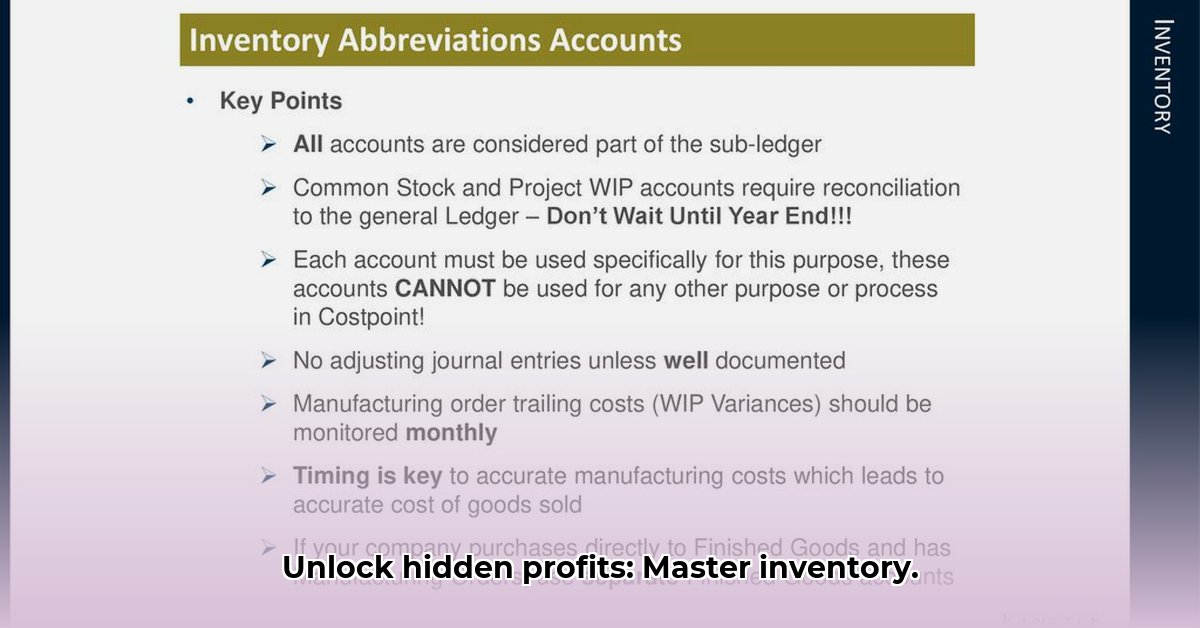
Inventory management is the unsung hero of profitability. Mastering it transforms your business from reactive to proactive, maximizing efficiency and minimizing waste. This guide provides actionable strategies, proven techniques, and technological solutions to optimize your inventory and boost your bottom line. Are you ready to unlock the full potential of your inventory?
Understanding Your Inventory: Beyond the Physical Stock
Your inventory encompasses raw materials, work-in-progress, and finished goods – all assets awaiting sale. Efficient management ensures the right quantity of each item is available at the right time. Excess inventory ties up capital in storage costs, insurance, and risks obsolescence; insufficient stock leads to lost sales and dissatisfied customers. A balanced approach is key. What's your current inventory picture? Do you have a system to manage or primarily rely on gut feeling? Honest self-assessment is your first step toward improvement.
Key Performance Indicators (KPIs) for Inventory Success
Measuring your inventory's performance hinges on several critical KPIs. These metrics provide a clear picture of your efficiency and profitability.
Inventory Turnover: This ratio reveals how quickly your inventory sells (Cost of Goods Sold / Average Inventory). A high turnover indicates efficient sales and minimal storage costs. For example, an inventory turnover of 6 indicates that your average inventory is sold and replaced six times a year.
Carrying Costs: These encompass storage costs, insurance, taxes, potential spoilage, and the opportunity cost of capital tied up in unsold goods. Reducing carrying costs directly boosts your profit margin. Did you know that carrying costs can easily account for 20-30% of your inventory value?
Stockout Rate: This metric shows how often you run out of specific items (Number of Stockouts / Total Number of Order Attempts). A high stockout rate signifies unmet demand and lost revenue. A low stockout rate, on the other hand, means strong customer satisfaction.
Fill Rate: This represents the percentage of orders fulfilled immediately from available stock (Number of Orders Filled / Total Number of Orders). A high fill rate points to efficient inventory management and satisfied customers – a direct positive impact on customer retention.
Streamlining Your Inventory Process: A Step-by-Step Approach
Optimizing inventory management isn't about guesswork; it's a systematic process. Follow these steps to gain control:
Implement a Robust Inventory Management System (IMS): Choose a system—from spreadsheets for small businesses to sophisticated ERP systems for larger enterprises—that provides real-time visibility into stock levels. A powerful IMS is the foundation of efficient inventory management.
Master Demand Forecasting: Accurately predicting future demand is crucial. Leverage historical sales data, market trends, and seasonal variations. Consider utilizing forecasting software to enhance prediction accuracy. Accurate forecasting can improve your fill rate by up to 15%.
Optimize Your Ordering Process: Establish a streamlined ordering system, factoring in lead times and order quantities to minimize costs. Build strong relationships with reliable suppliers to ensure timely deliveries. A well-managed supply chain is essential for operational efficiency.
Continuous Monitoring and Adaptation: Inventory management is ongoing. Regularly review your KPIs, adapt strategies based on performance, and stay flexible to respond to market changes. Regular review and adaptation is paramount to long-term success.
Leveraging Technology for Inventory Management Excellence
Technology plays a vital role in modern inventory management:
Radio Frequency Identification (RFID) (small electronic tags that transmit data wirelessly): RFID tags enable real-time inventory tracking, eliminating manual counts and improving accuracy significantly.
Artificial Intelligence (AI) (computer systems designed to mimic human intelligence): AI-powered forecasting tools analyze extensive data to generate accurate demand predictions, minimizing stockouts and excess inventory.
Internet of Things (IoT) (network of physical objects embedded with sensors and software): IoT sensors provide real-time data on inventory levels and location, offering complete visibility across the supply chain.
Addressing Common Inventory Management Challenges
Even with careful planning, challenges may arise. Here are common hurdles and mitigation strategies:
| Challenge | Mitigation Strategy |
|---|---|
| Inaccurate Forecasting | Implement advanced forecasting techniques, incorporating real-time sales data and regularly refining prediction models. |
| Poor Data Visibility | Use a robust IMS with real-time updates and reporting features. |
| Supply Chain Disruptions | Diversify your supplier base, develop strong supplier relationships, and incorporate buffer stock into your planning. |
| Obsolescence | Regularly review slow-moving inventory, and consider implementing discounts or alternative sales channels. |
By implementing these strategies and embracing technological advancements, you can transform your inventory management from a challenge into a powerful driver of profitability. Remember, consistent effort and continuous improvement are key to long-term success. What steps will you take today to optimize your inventory management?